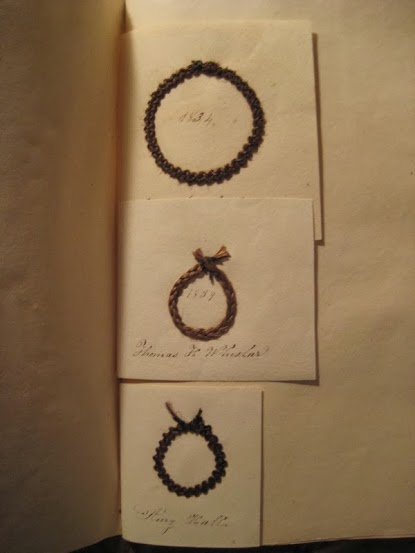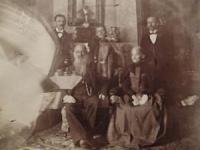Now that it's October, my mind is on Halloween. Especially since our recent visit to Historic Sugartown uncovered some exemplars of eerie Victorian-era practices, namely a post-mortem daguerreotype and a hair album!
I should clarify that Historic Sugartown (in Chester County, Pennsylvania) is itself lovely, charming, and not at all eerie. Actually, it is probably the contrast between the quaint village of restored 19th century buildings and the several somewhat morbid items buried in its archives that made those items stand out.
Post-mortem photographs were a not uncommon practice in the Victorian era. Photography made it possible to capture people's likenesses, but in the early days before personal cameras it could be inconvenient and somewhat costly to travel to a photography studio for a portrait. If death came before a loved one had the chance to sit for a portrait, sentimental Victorians sometimes took the recently-deceased to have one taken before burial. At the time it was not considered morbid at all, but a form of loving remembrance. It is a phenomenon I had heard about before--the movie "The Others" even brings it up--but after working as an archivist for several years I still had not come across one myself until Historic Sugartown. (For more information about post-mortem photographs, see Jay Ruby's book Secure the Shadow.)

Post-mortem daguerreotype from the Williams family photographs at Historic Sugartown, circa 1850s
Another Victorian practice that seems bizarre in retrospect is collecting locks of hair from family and friends as keepsakes. Often the locks were intricately braided, and at times fashioned into elaborate art pieces. Very commonly the locks were kept in an album, kind of like an autograph album. (A modern reader could make an analogy to a genetic signature, although of course Victorians did not know about DNA.) Hair keepsakes were prevalent enough that I have encountered them time and again working as an archivist, although I continue to find them, if you will pardon the pun, hair-raising.

Page (above) and detail (below) from Hall hair album, circa 1840s

The two items I discussed in this blog post have novelty value, but they are only a small part of larger, interesting archival collections. Historic Sugartown has over 100 years of business records and family papers from the Worrall and John families, who ran a general store, post office, and later an antiques shop in the town. That collection tells the story of Sugartown's growth as a small commercial crossroads in the midst of farm country during the 19th and early 20th centuries; it also bespeaks the struggles of a family working to run a successful business to pass down a legacy across the generations. The narratives embedded in the Worrall and John family's papers are supported by small manuscript collections from other people, families, and organizations, also held at Historic Sugartown.
Historic Sugartown is a rich resource for subjects ranging far beyond Victorian eeriness, with enough to keep researchers interested past Halloween and through the rest of the year.

